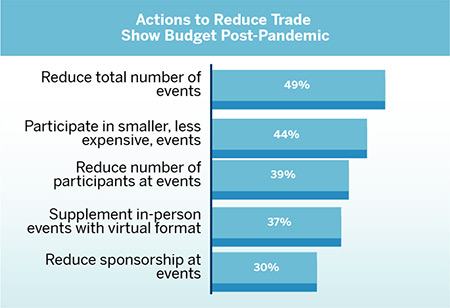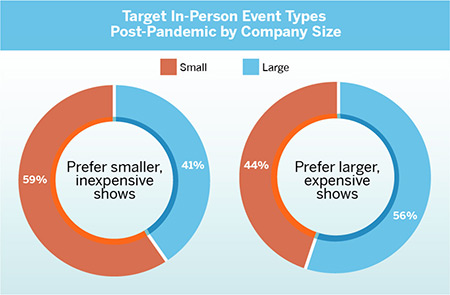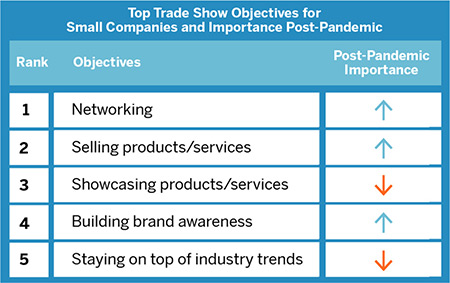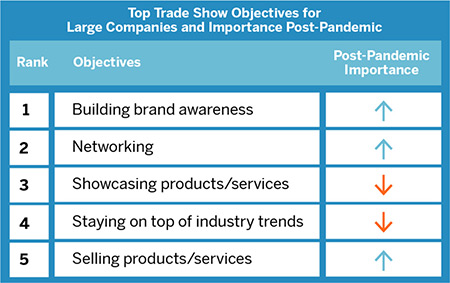- Home
- / Insights
- / FTI Journal
The Future of Trade Shows is Omnichannel

-
April 14, 2021
-
The rise of virtual events raises questions about the state of in-person trade shows. An FTI Consulting survey shows there’s an appetite for a new model.
For years, trade shows have played a prominent role in business, serving as the backbone for networking and product showcasing. That operating principle got shelved with the arrival of COVID-19, however. Without the freedom to stage in-person events, trade shows took a major financial hit in 2020. Just for cancellations as of March 2020 alone, these cancellations resulted in an economic loss of $14 billion to $22 billion according to an estimate by the Center for Exhibition Industry Research.1
In December, FTI Consulting’s Media & Entertainment practice set out to gain insight into the future of the in-person trade show through a survey of nearly 500 company decision makers in the U.S. and U.K. These individuals have direct authority to allocate budget and/or sponsorship funds toward trade show events.
The survey results showed the cancellation of in-person events had caused participants to rethink their trade show budgets.2 When asked how their allocations will shift in a post-pandemic, post-lockdown world, more than half of respondents (58%) indicated their current budget had decreased when compared to pre-COVID levels.3

But the results also showed reason for optimism: 46% of respondents indicated they intend to increase their trade show budgets to above pre-pandemic levels.4
Now, as the prospect of more in-person events returns, those holding the purse strings must decide on how to allocate resources: Should funds go toward face-to-face trade shows, virtual or some kind of hybrid? FTI Consulting’s survey results can shed light.
Virtual Events Are Here to Stay — And Grow
Trade shows are critical platforms for networking, lead generation, branding and knowledge development. To that end, survey respondents indicated they are eager to resume face-to-face trade show participation following the unprecedented disruption of 2020 to increase awareness of their companies’ products and services.5
Even those who said they plan to pull back on trade show spending are raring to go. Of the 27% of respondents who anticipate lower post-pandemic budgets, 49% said they will manage by reducing the number of events they attend.6
Despite the desire to return to normal, however, attendees will likely find themselves continuing to consider virtual events. As is well documented, the cancellation of in-person shows forced many operators to pivot and provide an online version as a temporary substitute. Not surprisingly, budgets leaned heavily in this direction last year, encompassing 64% of overall trade show spending on average.7 Though that spending line will decline by 13%, say respondents, it will still hold a majority share (55%) of the overall trade show budget post-pandemic.8
What may be surprising, however, is just how popular those substitute events proved to be. Nearly 70% of respondents indicated they had attended a virtual event in the past year, with a remarkable 62% reporting they were more satisfied with the experience when compared to in-person events.9
Preferences and Priorities: Small Versus Large Companies
FTI Consulting surveyed the decision makers about various preferences and priorities for trade shows in a post-pandemic world. The results showed a distinct demarcation between the desires of smaller-sized companies (annual revenues of <$50M) and those of larger-sized companies (annual revenues of >$50M).

For instance, when asked to name the size of in-person events they wanted to target, smaller companies indicated a preference for smaller, inexpensive shows; larger companies said larger, more expensive shows.10
A similar small vs. large distinction appeared when respondents were asked to rank trade show objectives and indicate the relative importance of each. Smaller companies, which tend to be less financially resilient than larger companies, chose “networking” as number 1, followed by “selling products & services.”11 In contrast, larger companies, which generally have access to a greater variety of capital to weather a crisis, ranked “increasing brand awareness” atop their list. (“Networking” was number 2).12


Those preferences should inform trade show operators. Regardless of event type, they will need to deliver an experience catered to customers’ specific needs in a post-pandemic world that offers more choice via virtual events.
Trade Show Operators: Optimizing Spend
Trade show operators have their work cut out for them after an unprecedented year of disruption. Delivering customer value in the new normal will require them to:
- Reassess their current event portfolios to determine which events should be transformed versus maintained.
- Reassess customer segmentation to address shifting priorities.
- Address any capability gaps in serving a new portfolio of hybrid and virtual events.
- Transform a lean cost and efficient capital structure.
The good news is participants are eager to return to the convention center, and that desire indicates overall demand. Virtual trade shows, though a temporary substitute amid the pandemic, will likely remain and grow in a post-pandemic world. Each trade show participant will shift its budget and priorities differently going forward, and it will be important for trade show operators to understand and align with these changes.
The views expressed herein are those of the author(s) and not necessarily the views of FTI Consulting, Inc., its management, its subsidiaries, its affiliates or its other professionals. FTI Consulting, Inc., including its subsidiaries and affiliates, is a consulting firm and is not a certified public accounting firm or a law firm.
Footnotes:
1: Center for Exhibition Industry Research, March 2020
2: FTI Survey Question: Compared to pre-COVID, how has your current trade show budgeting changed?
3: FTI Survey Question: Compared to pre-COVID, how do you anticipate your trade show budget will change in a post-COVID world?
4: lbid
5: FTI Survey Question: How would you rate your virtual event satisfaction compared to a physical, in-person event?
6: FTI Survey Question: How do you anticipate reducing your budget going forward?
7: FTI Survey Question: For each of the following time periods, what percent of your total trade show budget has been/is dedicated to in-person events vs. virtual events?
8: lbid
9: FTI Survey Question: How would you rate your virtual event satisfaction compared to a physical, in-person event?
10: FTI Survey Question: Which type of in-person trade shows do you expect to target in a post-COVID world?
11: FTI Survey Analysis
12: lbid
© Copyright 2021. The views expressed herein are those of the author(s) and not necessarily the views of FTI Consulting, Inc., its management, its subsidiaries, its affiliates, or its other professionals.
About The Journal
The FTI Journal publication offers deep and engaging insights to contextualize the issues that matter, and explores topics that will impact the risks your business faces and its reputation.
Published
April 14, 2021
 Key Contacts
Key Contacts
Senior Managing Director
Senior Managing Director
Senior Consultant


